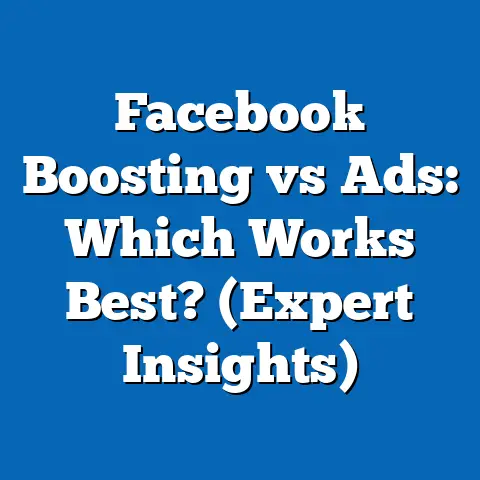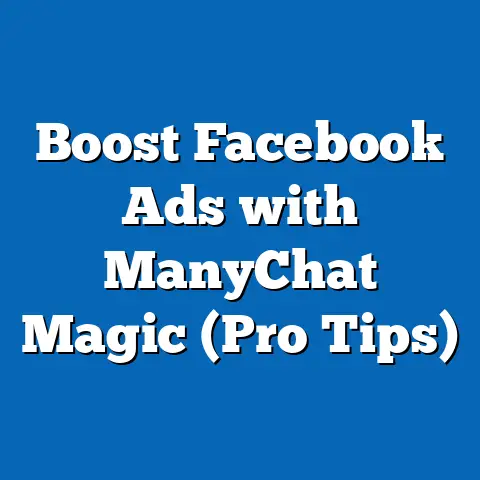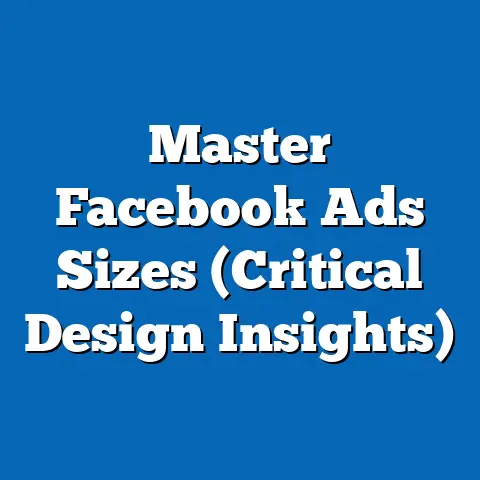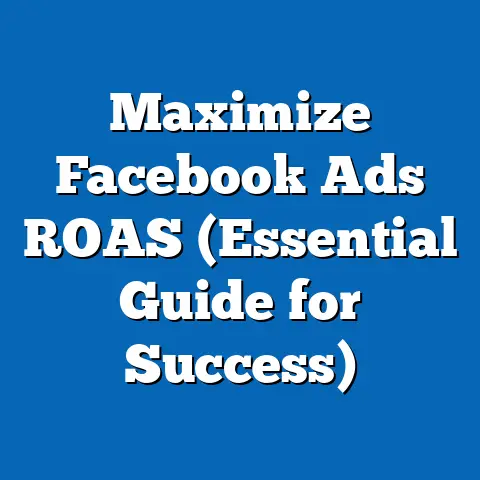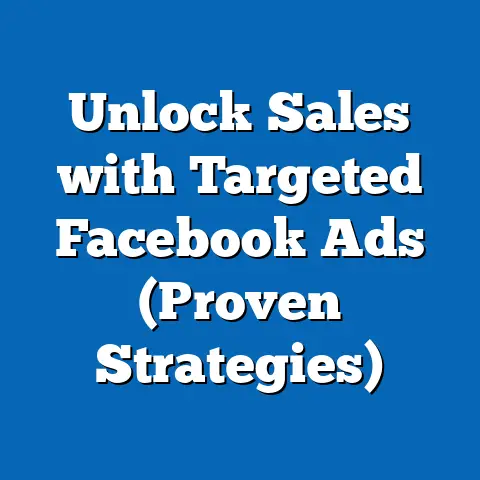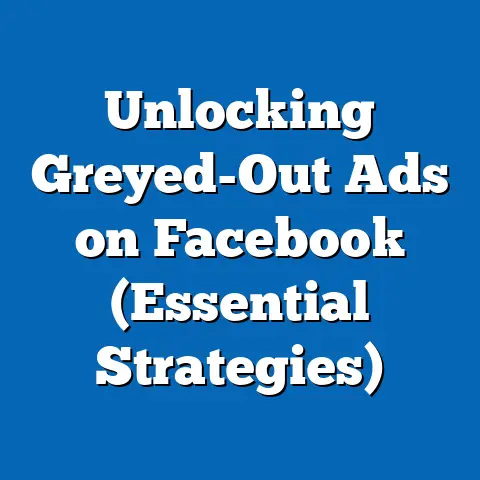Master Facebook Ad Targeting in 2025 (Expert Strategies)
Imagine the ancient Greek agora, a bustling marketplace where merchants tailored their pitches to the diverse crowds—philosophers, laborers, and aristocrats alike—knowing precisely who would respond to their wares. Today, in the vast digital expanse of social media, Facebook stands as the modern agora, a platform where over 3 billion monthly active users converge, each with unique interests, behaviors, and needs. For marketers, mastering Facebook ad targeting in 2025 is akin to becoming a master orator in this virtual marketplace, crafting messages that resonate with precision amid an ever-shifting landscape of technology, privacy regulations, and user expectations.
Facebook, launched in 2004 as a college networking site, has evolved into a global powerhouse of social interaction and advertising, shaping how businesses connect with consumers. Its ad targeting capabilities, driven by vast data troves and sophisticated algorithms, have redefined digital marketing since the introduction of its advertising platform in 2007. As we stand at the threshold of 2025, the societal implications of this evolution are profound—Facebook’s influence extends beyond commerce to political discourse, cultural trends, and even personal identity formation, raising critical questions about privacy, ethics, and the balance of power in digital spaces.
Historical Context: The Evolution of Facebook Advertising
Facebook’s journey from a dorm-room project to a digital advertising titan is a story of innovation and adaptation. Initially launched as a platform for connecting college students, it opened to the public in 2006 and introduced its first advertising model—Flyers—in the same year, allowing businesses to promote events or products for a small fee. However, it was the 2007 launch of Facebook Ads that marked a turning point, introducing targeted advertising based on user demographics like age, location, and interests, a novelty at the time.
By 2012, with the introduction of Custom Audiences, advertisers could upload customer data to target specific individuals, while Lookalike Audiences allowed them to reach users similar to their existing base. These tools, powered by Facebook’s growing data collection capabilities, transformed the platform into a precision marketing engine. The 2018 Cambridge Analytica scandal, however, exposed the darker side of this data-driven approach, revealing how user information could be exploited for political manipulation, leading to public outcry and stricter privacy regulations like the GDPR in Europe.
The early 2020s brought further challenges with Apple’s iOS 14.5 update in 2021, which introduced App Tracking Transparency (ATT), limiting Facebook’s ability to track users across apps and websites. This shift, coupled with evolving global privacy laws, forced Meta (Facebook’s parent company) to pivot toward on-platform data and machine learning to maintain targeting efficacy. As we approach 2025, historical lessons from data misuse and regulatory pushback continue to shape Facebook’s advertising ecosystem, pushing marketers to balance precision with ethical responsibility.
Societally, Facebook’s ad targeting evolution reflects broader tensions between personalization and privacy. While targeted ads have fueled economic growth—generating $113.6 billion in ad revenue for Meta in 2022—they’ve also contributed to echo chambers, misinformation, and consumer distrust. Understanding this historical backdrop is crucial for marketers crafting strategies in 2025, as it underscores the need for transparency and adaptability in an era of heightened scrutiny.
Defining Characteristics of Facebook Ad Targeting in 2025
As we look to 2025, several defining characteristics shape Facebook ad targeting, reflecting technological advancements, user behavior shifts, and regulatory landscapes. First, the reliance on first-party data has become paramount due to restrictions on third-party tracking. Meta’s investments in on-platform analytics and tools like the Conversions API enable advertisers to leverage data directly from user interactions on Facebook and Instagram, ensuring compliance with privacy standards while maintaining targeting accuracy.
Second, artificial intelligence (AI) and machine learning dominate targeting algorithms, with Meta’s Advantage+ suite automating ad placement, creative optimization, and audience selection. These tools, rolled out in the early 2020s, have matured by 2025 to offer hyper-personalized ad experiences, predicting user behavior with unprecedented precision based on real-time data. However, this automation comes with a learning curve, requiring marketers to trust algorithms over manual control—a shift that can be daunting for traditional advertisers.
Third, the focus on generational and cultural nuance in targeting has intensified. With users spanning Gen Z (born 1997-2012), Millennials (born 1981-1996), Gen X (born 1965-1980), and Baby Boomers (born 1946-1964), Facebook’s audience is more diverse than ever. Each generation engages with the platform differently—Gen Z prioritizes authenticity and short-form content, while Boomers value informational ads—necessitating tailored strategies that avoid one-size-fits-all approaches.
Finally, privacy-first advertising defines the 2025 landscape. With regulations like the California Privacy Rights Act (CPRA) and potential federal privacy laws in the U.S., alongside global frameworks like GDPR, advertisers must prioritize consent-based targeting and transparent data practices. This shift not only impacts how audiences are built but also reshapes user trust, a critical factor in ad effectiveness.
Societal Implications: Balancing Innovation and Ethics
The societal stakes of Facebook ad targeting in 2025 are high, as the platform’s influence permeates personal, cultural, and political spheres. On one hand, precise targeting drives economic value by connecting businesses with relevant consumers, supporting small enterprises and fostering innovation in e-commerce. According to eMarketer, social media ad spending is projected to exceed $200 billion globally by 2025, with Facebook retaining a significant share due to its targeting prowess.
On the other hand, the potential for misuse remains a pressing concern. Targeted ads have been linked to the spread of misinformation, as seen in past election cycles where microtargeting amplified divisive content. By 2025, with AI-driven personalization at its peak, the risk of creating hyper-polarized echo chambers intensifies, necessitating robust content moderation and ethical guidelines from Meta and advertisers alike.
Privacy concerns also loom large. While users benefit from relevant ads, many feel uneasy about the extent of data collection, with 74% of U.S. adults expressing concern over how companies use their personal information, per a 2023 Pew Research Center survey. This distrust can erode engagement, pushing marketers to adopt transparent practices and offer value-driven content to maintain credibility.
Culturally, Facebook ad targeting shapes trends by amplifying certain voices over others. For instance, Gen Z’s preference for social causes means brands targeting this demographic often align with sustainability or inclusivity, influencing broader societal narratives. However, this can also lead to performative marketing if not handled authentically, highlighting the need for genuine engagement over opportunistic messaging.
Technological Factors Shaping Targeting Strategies
Technology is the backbone of Facebook ad targeting in 2025, with several advancements driving strategic innovation. AI remains the cornerstone, with Meta’s algorithms analyzing billions of data points to predict user intent, optimize ad delivery, and reduce costs per conversion. Advantage+ campaigns, for example, reported a 20% lower cost per acquisition compared to manual campaigns in early tests, per Meta’s 2023 reports, a trend likely to strengthen by 2025.
Augmented reality (AR) and interactive ad formats also redefine engagement. With the rise of the metaverse and AR tools integrated into Facebook and Instagram, advertisers can create immersive experiences—think virtual try-ons for fashion or 3D product demos—that capture attention, especially among younger users. These formats require precise targeting to ensure relevance, as irrelevant AR ads risk alienating audiences.
Moreover, the decline of third-party cookies, fully phased out by Google Chrome by late 2024, accelerates the shift to contextual targeting. By 2025, Facebook’s ability to infer interests from on-platform activity (e.g., group memberships, liked pages) becomes critical, though it demands a deeper understanding of user behavior to avoid missteps. Marketers must also contend with cross-platform integration, as users toggle between Facebook, Instagram, WhatsApp, and external sites, necessitating unified data strategies within Meta’s ecosystem.
Economic and Competitive Landscape
Economically, the stakes for mastering Facebook ad targeting in 2025 are immense, as businesses vie for consumer attention in a crowded digital space. Meta’s ad revenue model, reliant on small and medium-sized businesses (SMBs), means that accessible, effective targeting tools are vital for economic inclusivity. SMBs, which account for over 90% of Meta’s advertisers, benefit from low-cost entry points but face challenges in competing with larger brands wielding bigger budgets and data resources.
Competition from platforms like TikTok and YouTube also pressures Facebook to innovate. TikTok’s viral, algorithm-driven content model appeals to Gen Z, with 67% of U.S. teens using the platform daily per a 2023 Pew survey, compared to 62% for Instagram and 59% for Facebook. To retain market share, Meta has doubled down on short-form video via Reels, integrating advanced targeting to rival TikTok’s organic reach with paid precision.
Inflation and economic uncertainty in the mid-2020s further complicate ad spending. Marketers must justify every dollar, pushing for hyper-efficient targeting that maximizes return on ad spend (ROAS). This economic reality underscores the importance of leveraging AI tools and first-party data to minimize waste and drive conversions in a cost-conscious environment.
Expert Strategies for Facebook Ad Targeting in 2025
Navigating the complexities of Facebook ad targeting in 2025 demands a blend of creativity, technical acumen, and ethical foresight. Below are expert strategies to optimize campaigns while addressing current challenges and opportunities.
1. Leverage First-Party Data with Precision
With third-party tracking diminished, building robust first-party data pools is non-negotiable. Use tools like Meta Pixel and Conversions API to capture on-site and in-app actions, ensuring compliance with consent requirements. Encourage user engagement through lead magnets—quizzes, downloadable content, or loyalty programs—to collect valuable data directly.
Segment these audiences meticulously based on behavior, purchase history, and engagement levels. For instance, target cart abandoners with dynamic product ads while nurturing new leads with educational content. This approach not only aligns with privacy norms but also boosts relevance, with personalized ads yielding 40% higher click-through rates, per a 2023 HubSpot study.
2. Master Advantage+ and AI-Driven Campaigns
Meta’s Advantage+ suite is a game-changer for 2025, automating audience expansion and creative testing. Start by feeding the algorithm high-quality inputs—diverse ad creatives, clear campaign objectives, and historical data—to accelerate learning. Trust the system to identify untapped audiences, but monitor performance closely to avoid over-reliance on automation.
Combine AI insights with human intuition. For example, if Advantage+ suggests a new demographic, analyze why—perhaps a cultural trend or seasonal shift—before scaling. This hybrid approach balances efficiency with strategic control, maximizing ROAS in an AI-dominated landscape.
3. Tailor Content to Generational Nuances
Generational diversity on Facebook requires bespoke targeting. For Gen Z, prioritize authenticity and social impact, using Reels or Stories with user-generated content (UGC) to build trust—68% of Gen Z trust peer recommendations over brand messaging, per a 2023 Edelman report. Millennials, often in decision-making life stages, respond to value-driven offers like discounts or family-oriented messaging.
Gen X and Boomers, while less tech-savvy, value clarity and utility. Use carousel ads to showcase product benefits or testimonials, targeting based on interest in legacy categories like home improvement or financial services. Avoid stereotyping—within each generation, subcultures and individual preferences vary, so test and refine messaging continuously.
4. Embrace Interactive and Immersive Formats
AR and interactive ads are no longer novelties but necessities for engagement in 2025. Develop AR experiences—like virtual store walkthroughs or product try-ons—that align with user interests, targeting based on past interactions with similar content. For instance, beauty brands can target users who’ve engaged with makeup tutorials.
Use polls, quizzes, and playable ads to drive interaction, especially among younger users who crave gamification. These formats not only boost engagement but also provide behavioral data for further targeting, creating a feedback loop of relevance and insight.
5. Prioritize Privacy and Transparency
In a privacy-first world, transparency is a competitive advantage. Clearly communicate data usage in ad copy or landing pages, offering opt-in incentives like exclusive content for sharing preferences. Use Meta’s privacy tools to ensure compliance with regional laws—e.g., limiting sensitive data usage in GDPR zones.
Build trust through value exchange. Instead of intrusive retargeting, offer helpful reminders or personalized recommendations. A 2023 Nielsen study found that 62% of users are more likely to engage with brands that respect privacy, making ethical targeting a business imperative.
6. Optimize for Cross-Platform Synergy
Users in 2025 rarely stay on one platform, so integrate targeting across Meta’s ecosystem—Facebook, Instagram, WhatsApp, and Messenger. Use unified audience insights to create seamless experiences, retargeting Instagram engagers with Facebook ads or driving WhatsApp conversations for customer service.
Test cross-platform creative variations to identify what resonates where. For instance, Instagram Stories may excel with visual storytelling for Gen Z, while Facebook feed ads work better for detailed offers to older users. This synergy maximizes reach without duplicating effort, a critical efficiency in tight budgets.
7. Monitor and Adapt to Regulatory Shifts
Regulatory landscapes will continue evolving in 2025, with potential U.S. federal privacy laws and stricter enforcement globally. Stay ahead by partnering with legal experts to audit data practices and ensure compliance. Use Meta’s ad transparency tools to disclose targeting criteria, preempting user or regulatory backlash.
Prepare contingency plans for data restrictions, such as focusing on contextual targeting or broad interest categories if detailed demographics are curtailed. Agility in adapting to policy changes will distinguish leaders from laggards in the ad space.
Comparative Analysis: Generational Engagement on Facebook
Understanding how generations engage with Facebook ads in 2025 is critical for nuanced targeting. Gen Z, digital natives, prioritize visual, snackable content—Reels and Stories drive 70% of their engagement, per a 2023 Meta report. They’re skeptical of overt sales pitches, favoring brands with social missions or influencer partnerships.
Millennials, balancing career and family, seek convenience and value. They engage with ads offering time-saving solutions or community-driven content, often via groups or events. Their click-through rates peak with personalized offers, reflecting their life-stage needs.
Gen X, often overlooked, values reliability and nostalgia in ads. They respond to detailed product information and trust-building elements like reviews, with higher conversion rates on desktop than mobile, unlike younger cohorts. Boomers, growing in digital fluency, engage with informational content—think health or retirement ads—but require clear calls-to-action due to lower ad tolerance.
These differences highlight the need for segmented strategies. While Gen Z and Millennials thrive on mobile-first, dynamic content, Gen X and Boomers need accessible, trust-centric approaches. Yet, within each group, diversity abounds—cultural, economic, and personal factors shape responses, necessitating continuous testing over broad assumptions.
Implications for Businesses and Society
For businesses, mastering Facebook ad targeting in 2025 offers a pathway to growth amid economic and competitive pressures. Precision targeting reduces ad waste, enabling SMBs to compete with giants, while AI tools democratize access to sophisticated marketing. However, over-reliance on automation risks losing brand voice, and privacy missteps can damage reputation overnight.
Societally, the ripple effects are vast. Targeted ads influence consumer behavior, cultural norms, and even political outcomes, as seen in past controversies. By 2025, with AI amplifying personalization, the potential for both positive impact (e.g., tailored education campaigns) and harm (e.g., misinformation) grows, urging stakeholders to prioritize ethics.
In the workplace, marketing teams must upskill in AI, data analysis, and compliance, reshaping hiring and training. Cross-generational collaboration also becomes key, as diverse teams better understand varied user mindsets. The broader challenge lies in balancing innovation with responsibility—a theme that will define digital advertising’s societal role.
Conclusion: Looking Ahead with Strategic Foresight
As we peer into 2025, mastering Facebook ad targeting emerges as both an art and a science, blending cutting-edge technology with human insight. The strategies outlined—leveraging first-party data, embracing AI, tailoring to generations, and prioritizing privacy—offer a roadmap for navigating a landscape shaped by innovation and constraint. Yet, uncertainties remain: How will evolving regulations redefine data access? Can Meta sustain user trust amid growing scrutiny?
The future of Facebook advertising hinges on adaptability. Marketers must stay agile, testing new tools like AR while grounding campaigns in ethical principles. As the digital agora continues to evolve, those who master its nuances will not only drive business success but also shape how society engages with technology—a dual responsibility that demands both skill and vision.
By understanding historical lessons, current trends, and forward-looking strategies, advertisers can position themselves as leaders in 2025’s complex ad ecosystem. The journey is challenging, but the rewards—relevance, connection, and impact—are worth the pursuit. Let this be the year to refine, innovate, and inspire in the ever-dynamic world of Facebook ad targeting.

